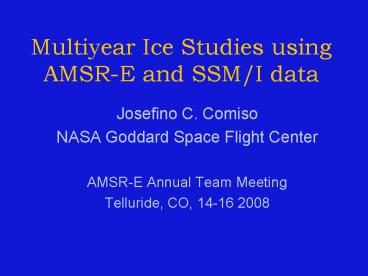Multiyear Ice Studies using AMSR-E and SSM/I data - PowerPoint PPT Presentation
1 / 22
Title: Multiyear Ice Studies using AMSR-E and SSM/I data
1
Multiyear Ice Studies using AMSR-E and SSM/I data
- Josefino C. Comiso
- NASA Goddard Space Flight Center
- AMSR-E Annual Team Meeting
- Telluride, CO, 14-16 2008
2
Scientific Motivations
- The Arctic perennial ice cover is retreating
rapidly. The decline means that the fraction of
thick ice type is decreasing and hence a thinning
in the ice cover. - Perennial ice consists of second and older ice
types. Could AMSR-E and SSM/I data be used to
sort out these two ice types? - Which ice type is declining the fastest? Can we
study separately the variability and trends of
the third and older ice types? - The perennial ice cover may transition into a
dominantly second year ice cover as in the
Antarctic before it becomes a totally seasonal
ice type. Can we detect when this happens?
3
The dramatic drop in the 2007 perennial ice cover
4
Data in Winter 2008 showed Coolingand some ice
recovery
Maximum Extent in 2008
5
5-year and yearly Averages of ice Area and Extent
6
Accelerated Trend in the Total Arctic Sea Ice
Cover
June?
(78 96)
(1978 to 1996)
(96-08)
(1996 to 2008)
7
Previous Studies on 2nd Year Ice
Tooma, S.G., et al., J. Glaciology 15(17),
225-239, 1975 Hollinger et al., J. Geophy. Res.,
1984.
FY
FY
SY
MY
SY
MY
8
Multi-channel Signatures of Arctic sea ice
- Distinct clusters are apparent in multi-channel
space. - The clusters appear to be persistent from one
year to another.
9
Arctic perennial ice and2nd year ice production
The blue area in the difference map likely
represents second year ice. The signature of
this ice is shown in the scatter plot (colored in
blue) during the following winter (15 Dec
1997). The scatter plot uses 36H vs 36V vs 18V
projected to the plane of the plot.
FY
SY
MY
10
Signature of 2nd year Icein 1997
In a 5 by 5 pixel study area, the temporal
change in the signature of ice with positive
anomalies and also those in the seasonal and
perennial ice regions are shown for 3 different
AMSR-E frequencies. The signature of 2nd year
ice is lower but closer to that of first year
ice types than the older ice types.
11
36V vs 18V vs 6V
Six Years Later 15 January 2003
6V vs 36V vs 89V
12
Cluster Map
Multiyear ice Map
sub sonar Wadhams
13
Multiyear ice cover using AMSR-E Data
FY
FY
MY
MY
FY
MY
14
Multiyear Ice Cover using SSM/I data
FY
MY
FY
MY
15
(No Transcript)
16
SSM/I vs AMSR-E
17
TheWildCard?MultiYear Ice from 1981 to 1998
18
Winter and Summer MY/Perennial Ice Cover
19
Summary
- The multiyear ice information during the winter
period in the Arctic provides a means to assess
how the older ice types has been changing. - The signature of second year ice appears to be
intermediate but more similar to that of first
year ice. This explains the big difference in
area and extent of multiyear ice in winter as
compared to those of perennial ice. - Multichannel cluster analysis may provide the key
to sorting out ice types of different ages.
This will help evaluate how and why the ice
thickness has been changing. - The joint use of perennial and multiyear ice
retrievals may provide the means to identify when
the perennial ice transitions into a dominantly
2nd year ice cover.
20
(No Transcript)
21
End of Presentation
22
Arctic and Antarctic Extent and Area5-year ave.
and yearly from 2005 up to mid June 2008
14 June































